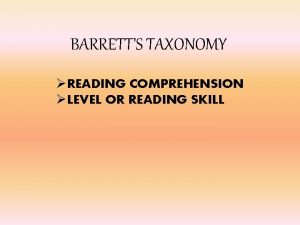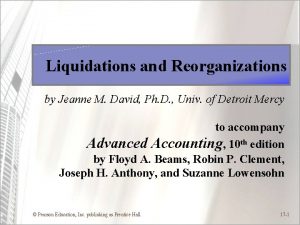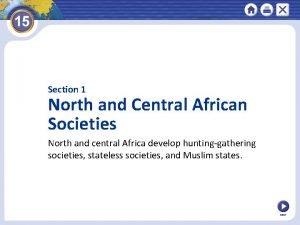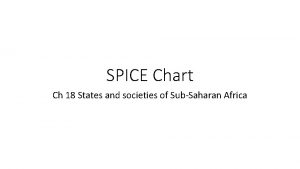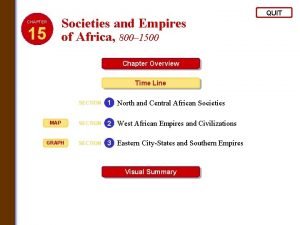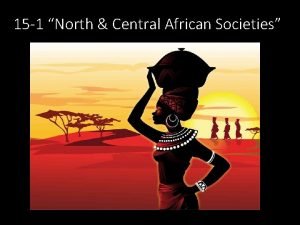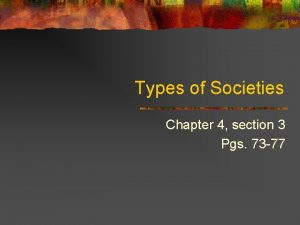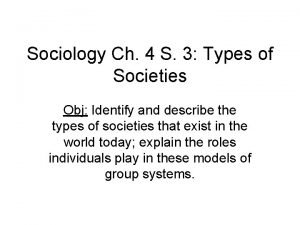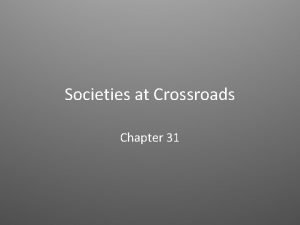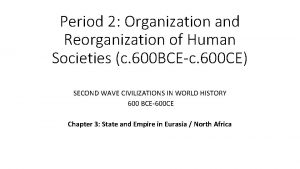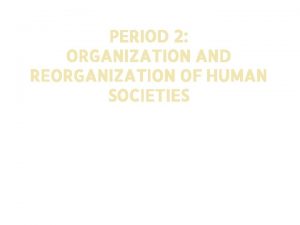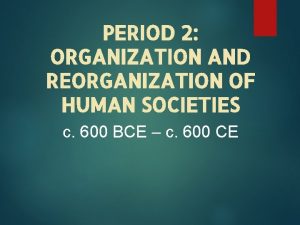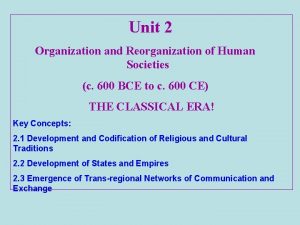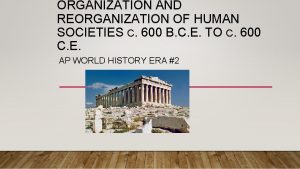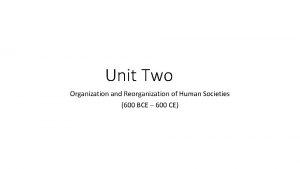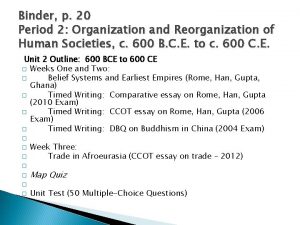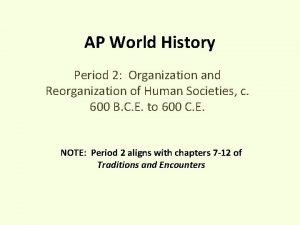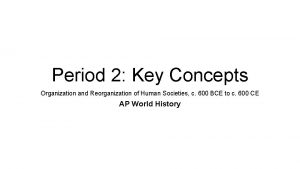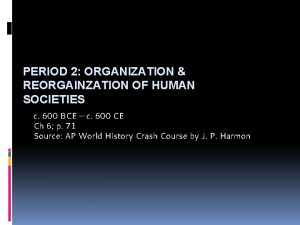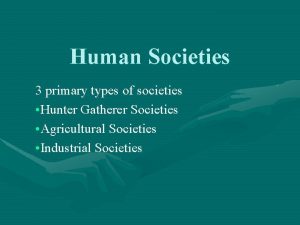Period 2 Organization and Reorganization of Human Societies




































- Slides: 36

Period 2: Organization and Reorganization of Human Societies c. 600 BCE – c. 600 CE Source: AP World History Crash Course by J. P. Harmon

600 BCE – 600 CE ❧ Known as the Classical Era ❧ Greatly influenced later generations as well as today ❧ Many religions that developed during this era had longterm effects world-wide ❧ Various cultural foundations also grew from this era ❧ Greek theater and democracy ❧ Confucianism ❧ Religious art and literature ❧ Mediterranean architecture


Existing Belief Systems Spread ❧ Hebrew (Judaism) spread to eastern Mediterranean and Central Asia by the Assyrians (600 BCE) and the Romans (70 CE) ❧ Hinduism created spiritual and social caste system and a long-term (still present) foundation for society ❧ Influenced by Vedic beliefs brought to India by the Indo European group – the Aryans – and merged into local tradition

Remember: Hinduism ❧ The Caste System ❧ Brahmin ❧ Priestly ❧ Kshaytria ❧ Ruling ❧ Vaisyas ❧ Sudra ❧ Laborer ❧ Pariah ❧ Untouchable ❧ The strongest social glue of India Pariah

New Religions Emerge From Old Hinduism __> Buddhism Judaism __> Christianity

Buddhism ❧ Began in Northern India c. 500 BCE ❧ Founder: Siddhartha Gautama ❧ Hindu of the Brahman class ❧ Called the Buddha or The Enlightened One ❧ Maintained Hinduism’s belief in reincarnation ❧ NO Caste System ❧ ALL share the same ability to reach Nirvana ❧ The closer to Nirvana, the less troubled one would be by the cares of this world

Buddhism ❧ Main teachings maintain that the point to live and to achieving Nirvan was to bring about the end of suffering ❧ The Four Noble Truths ❧ In life, there is suffering ❧ Suffering comes from selfish desire ❧ Those seeking the path to nirvana should strive to end suffering ❧ Suffering can end by following the Eight-Fold Path

Buddhism ❧ The Eight-Fold Path ❧ Right View ❧ Right Intention ❧ Right Speech ❧ Right Action ❧ Right Livelihood ❧ Right Effort ❧ Right Mindfulness ❧ Right Concentration

Buddhism ❧ The Buddha taught that questions about the existence of God were irrelevant. ❧ Those who truly followed the Eight-Fold Path would discover the truth regarding a Supreme Being when they reached nirvana

The Spread of Buddhism (5: 19)

Christianity ❧Began in Southwest Asia in the first century CE ❧Founder: Jesus, a Hebrew ❧ Preached salvation through faith in him, the Son of God ❧Jesus’s teachings were recorded in the Gospels and developed in other writings

Christianity ❧ Teaches equality among believers

Spreading Faiths ❧ Both Buddhism and Christianity gained more followers outside of their region of origin ❧ Buddhism spread east across the Indian Ocean and by the Silk Roads by missionaries and merchants ❧ Message of peace very appealing ❧ Buddhism changed to a Salvationist faith as it spread east – Mahayana ❧ Theravada – closer to original form

Religions Spread

Religions Spread

Spreading Faiths ❧ Christianity also gained popularity beyond it’s original birthplace ❧ Initially seen by the Roman government as disloyal to emperor and Christians were persecuted ❧ Emperor Constantine officially accepted Christianity in 4 th century CE ❧ Spread west by missionaries and merchants ❧ Eternal life and equality very appealing ❧ Was the “glue” that held Europe together during the chaos after the fall of Rome

Confucianism ❧ During the Warring States period in China (c. 500 BCE) ❧ Founder: Kong Fu Tzu (Confucius) ❧ Teaching compiled post-mortem in The Analects ❧ Set a clear set of rules for moral behavior and family and political order ❧ Filial piety ❧ utmost respect for parents ❧ Obedience to those in political control

Quotes from The Analects “The essence of knowledge is, having it, to apply it; not having it, to confess your ignorance. " "To be wronged is nothing unless you continue to remember it. " "It is only the wisest and the stupidest that cannot change. " "Everything has beauty, but not everyone sees it. " "Our greatest glory is not in never failing, but in rising every time we fall. “

Confucianism ❧ Five Relationships ❧ Ruler to Subject ❧ Father to Son ❧ Elder Brother to Younger Brother ❧ Husband to Wife ❧ Friend to Friend ❧ Shaped family and gender relationships as well as political and social relationships ❧ Patriarchial society

Confucianism ❧Confucius did not promise an eternal reward ❧Confucianism is a philosophy for this life, not a religion ❧Confucianism lasted and held China together for centuries

Daoism ❧ Also spelled Taoism ❧ Founder: Laozi– best known Taoist philosopher ❧ Developed around the same time as Confucianism in China and for the same reasons ❧ Teaches ❧ of the close connections between humans and nature ❧ Balance and harmony in all things ❧ Deep respect for ancestors

Daoism ❧ Encourages humans to look away from human creations and find peace and balance in nature’s examples ❧ Influential in Chinese medical practices such as ____________ ❧ Best known symbol – Yin-Yang

Animism and Shamanism ❧ Do not have written guidelines to shape adherents beliefs ❧ Most began in the oral tradition before writing ❧ Both hold great reverence for deceased ancestors who guide the lives of the living. (ancestor veneration) ❧ Continue to be popular in areas of Africa, Andes and some parts of the East Asia and Native America

Animism and Shamanism Animism ❧Belief that the natural world has spiritual powers ❧All things have a spirit and all spirits must be appeased Shamanism ❧ Belief that human spirit guides (shamans) are contacts between this world and the spirit world ❧ Shamans are also believed to have the power to heal physical and spiritual illnesses

Belief Systems and Gender Roles ❧Belief systems play a major part in development of gender roles ❧ Men dominate the leadership of all major religions ❧ Women sometimes served in similar capacities as priestesses, prophets and missionaries ❧ Both Buddhism and Christianity offer women opportunities to serve the religious communities as nuns

Classical Cultures Develops

Classical Civilization and the Arts ❧ This era developed many long-lasting forms of arts, including architecture, literature, paintings and sculpture ❧ Greek plays and histories influenced literature around the Mediterranean region and Western civilization ❧ Theatrical acting – dramas, comedies, tragedies that reflect the human condition ❧ Histories of their wars with the Persians and themselves became the “template” for western writing ❧ Believed that history was a good way to teach life’s lessons regarding good and bad behavior and their consequences

Greek Tragedy: A drama or play in which the main character is brought to ruin or suffers extreme sorry especially as a consequence of a flaw, moral weakness, or inability to cope with bad circumstances.

Classical Civilization and the Arts ❧ Indian epic poems continue to influence literature in South Asia with stories of self -sacrifice and devotion to duty and to the Hindu faith ❧ Ramayana ❧ Bhagavad Gita

Classical Civilization and the Arts ❧ Architecture from this era had long-lasting influence In China, India, Mesoamerica, and Mediterranean region ❧ In all classical regions, monumental building projects supported both the government and religious faith ❧ Mesoamerican temples looked very similar to Mesopotamian ziggurats

Teotihuacan temple

Parthenon – Temple in Ancient Greece

Buddhist place of meditation for monks: STUPA

Daoist Art: revering nature

Classical Civilization and the Arts ❧ Greek and Indian architectural styles blended as a result of Hellenism ❧ Religion themes prevailed in all regions ❧ Greek forms of sculpture reflected Hellenism as well ❧ Asian sculptures recognized Hindu, Buddhist or Confucian beliefs ❧ Daoist artists painted nature scenes to show their devotion
 Chapter 5 corporate liquidation and reorganization
Chapter 5 corporate liquidation and reorganization Perbedaan likuidasi partnership dan likuidasi corporate
Perbedaan likuidasi partnership dan likuidasi corporate Hematite
Hematite Reorganization energy
Reorganization energy Spatial reorganization
Spatial reorganization Barrett taxonomy reading comprehension
Barrett taxonomy reading comprehension Reorganization value adalah
Reorganization value adalah A&p flix activity: generation of an action potential
A&p flix activity: generation of an action potential When is the relative refractory period
When is the relative refractory period Trustee period and royal period
Trustee period and royal period Written records in history
Written records in history Block organization
Block organization The development of children 7th edition
The development of children 7th edition Critical period vs sensitive period
Critical period vs sensitive period Critical vs sensitive period examples
Critical vs sensitive period examples Approaches to child development
Approaches to child development What period lasted from 1750-1825?
What period lasted from 1750-1825? Metallic period 4 20 electrons
Metallic period 4 20 electrons Period of activism literature
Period of activism literature Stability period vs measurement period
Stability period vs measurement period Process organization in computer organization
Process organization in computer organization History helps us understand people and societies
History helps us understand people and societies North and central african societies
North and central african societies Refreshments trading account
Refreshments trading account Africa spice chart
Africa spice chart Is building societies larger than credit unions?
Is building societies larger than credit unions? Ib ess ia criteria
Ib ess ia criteria Chapter 15 societies and empires of africa
Chapter 15 societies and empires of africa Tandem language
Tandem language North and central african societies
North and central african societies Human resource management in retail management
Human resource management in retail management What do historians call the early period of human history
What do historians call the early period of human history Characteristic of pastoral societies
Characteristic of pastoral societies Simple horticultural societies
Simple horticultural societies Describe preindustrial societies of horticulturalists.
Describe preindustrial societies of horticulturalists. Types of societies
Types of societies Chapter 31 societies at crossroads outline
Chapter 31 societies at crossroads outline





